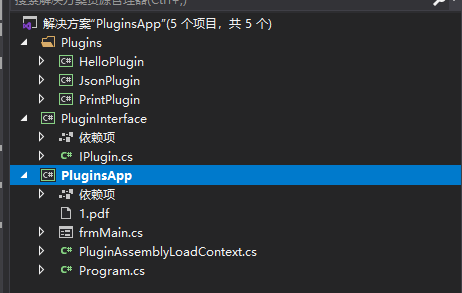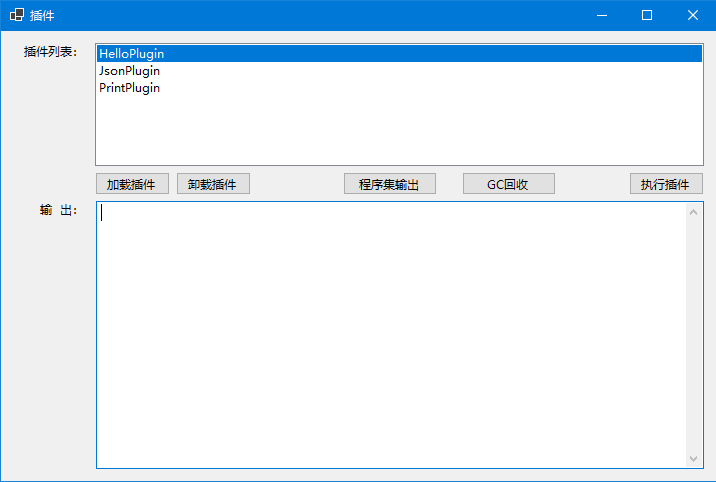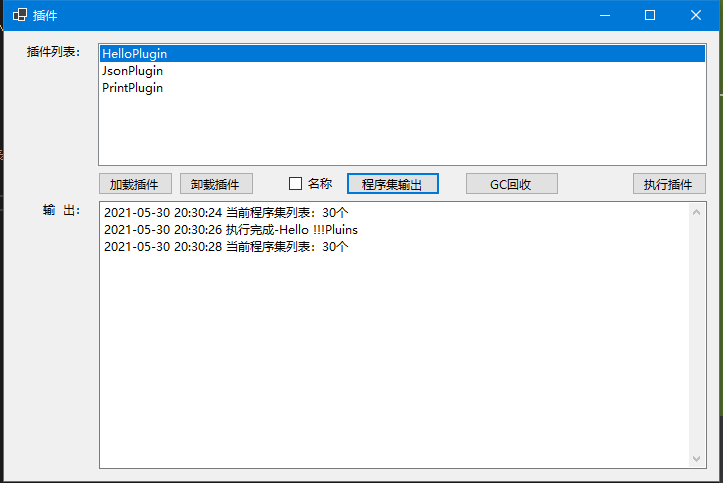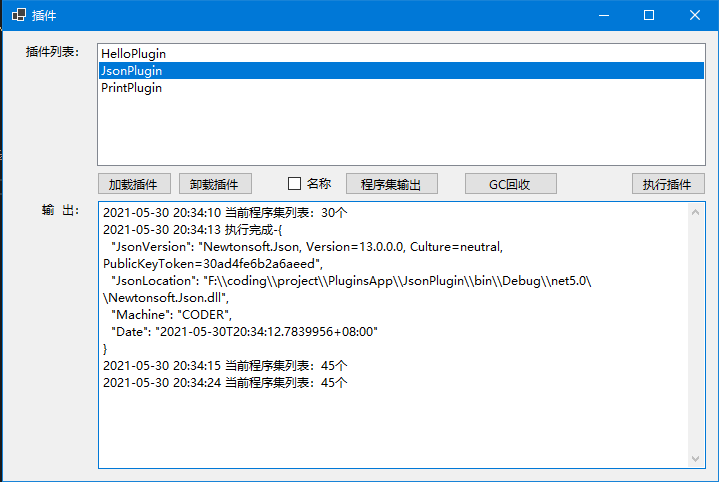.NET Core 中插件式开发实现
在 .NET Framework 中,通过AppDomain实现动态加载和卸载程序集的效果;但是.NET Core 仅支持单个默认应用域,那么在.NET Core中如何实现【插件式】开发呢?
一、.NET Core 中 AssemblyLoadContext的使用
1、AssemblyLoadContext简介:
每个 .NET Core 应用程序均隐式使用 AssemblyLoadContext。它是运行时的提供程序,用于定位和加载依赖项。只要加载了依赖项,就会调用 AssemblyLoadContext 实例来定位该依赖项。
-
它提供定位、加载和缓存托管程序集和其他依赖项的服务。
-
为了支持动态代码加载和卸载,它创建了一个独立上下文,用于在其自己的 AssemblyLoadContext 实例中加载代码及其依赖项。
2、AssemblyLoadContext和AppDomain卸载差异:
使用 AssemblyLoadContext 和使用 AppDomain 进行卸载之间存在一个值得注意的差异。对于 Appdomain,卸载为强制执行。
卸载时,会中止目标 AppDomain 中运行的所有线程,会销毁目标 AppDomain 中创建的托管 COM 对象,等等。对于 AssemblyLoadContext,卸载是“协作式的”。
调用 AssemblyLoadContext.Unload 方法只是为了启动卸载。以下目标达成后,卸载完成:
1、没有线程将程序集中的方法加载到其调用堆栈上的 AssemblyLoadContext 中。
2、程序集中的任何类型都不会加载到 AssemblyLoadContext,这些类型的实例本身由以下引用:
-
-
AssemblyLoadContext外部的引用,弱引用(WeakReference 或 WeakReference)除外。 -
AssemblyLoadContext内部和外部的强垃圾回收器 (GC) 句柄(GCHandleType.Normal 或 GCHandleType.Pinned)。
-
二、.NET Core 插件式方式实现
1、创建可卸载的上下文PluginAssemblyLoadContext
class PluginAssemblyLoadContext : AssemblyLoadContext
{
private AssemblyDependencyResolver _resolver;
///
/// 构造函数
/// isCollectible: true 重点,允许Unload
///
///
public PluginAssemblyLoadContext(string pluginPath) : base(isCollectible: true)
{
_resolver = new AssemblyDependencyResolver(pluginPath);
}
protected override Assembly Load(AssemblyName assemblyName)
{
string assemblyPath = _resolver.ResolveAssemblyToPath(assemblyName);
if (assemblyPath != null)
{
return LoadFromAssemblyPath(assemblyPath);
}
return null;
}
protected override IntPtr LoadUnmanagedDll(string unmanagedDllName)
{
string libraryPath = _resolver.ResolveUnmanagedDllToPath(unmanagedDllName);
if (libraryPath != null)
{
return LoadUnmanagedDllFromPath(libraryPath);
}
return IntPtr.Zero;
}
}
2、创建插件接口及实现
整体项目结构为:
a)添加项目PluginInterface,插件接口:
public interface IPlugin
{
string Name { get; }
string Description { get; }
string Execute(object inPars);
}
b)添加HelloPlugin项目,实现不引用外部dll插件
public class HelloPlugin : PluginInterface.IPlugin
{
public string Name => "HelloPlugin";
public string Description { get => "Displays hello message."; }
public string Execute(object inPars)
{return ("Hello !!!" + inPars?.ToString()); } }
c)添加JsonPlugin项目,实现引用三方dll插件
public class JsonPlugin : PluginInterface.IPlugin
{
public string Name => "JsonPlugin";
public string Description => "Outputs JSON value.";
private struct Info
{
public string JsonVersion;
public string JsonLocation;
public string Machine;
public DateTime Date;
}
public string Execute(object inPars)
{
Assembly jsonAssembly = typeof(JsonConvert).Assembly;
Info info = new Info()
{
JsonVersion = jsonAssembly.FullName,
JsonLocation = jsonAssembly.Location,
Machine = Environment.MachineName,
Date = DateTime.Now
};
return JsonConvert.SerializeObject(info, Formatting.Indented);
}
}
d)添加PluginsApp项目,实现调用插件方法:
修改窗体界面布局:
添加执行方法
///
/// 将此方法标记为noinline很重要,否则JIT可能会决定将其内联到Main方法中。
/// 这可能会阻止成功卸载插件,因为某些实例的生存期可能会延长到预期卸载插件的时间点之外。
///
///
///
///
/// 三、效果验证
1、非引用外部dll的插件执行:执行后对应dll成功卸载,程序集数量未增加。
2、引用外部包的插件:执行后对应dll未卸载,程序集数量增加。
通过监视查看对象状态:该上下文在卸载中。暂未找到原因卸载失败(疑问?)
四、总结
虽然微软文档说.NET Core中使用AssemblyLoadContext来实现程序集的加载及卸载实现,但通过验证在加载引用外部dll后,加载后不能正常卸载。或者使用方式还不正确。
源码地址:https://github.com/cwsheng/PluginsApp




